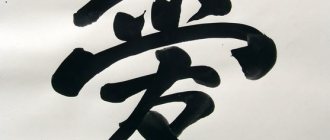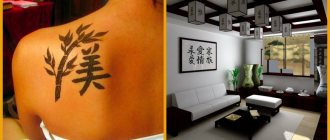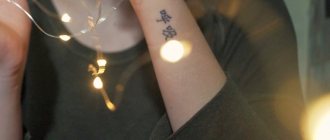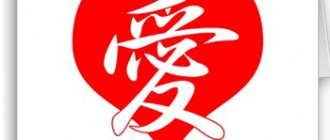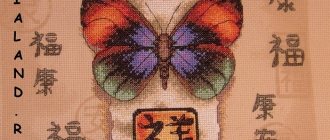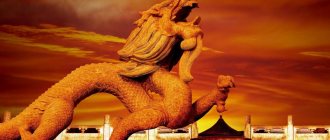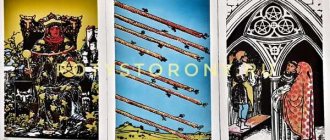The mysterious and diverse Chinese language has always aroused interest among Westerners. For the first time, sailors who arrived in China on merchant ships began to get tattoos with hieroglyphs on their bodies. These mysterious and attractive images continue to be in high demand. This article details popular Chinese characters for stylish tattoos and reveals their meaning.
Interesting fact: Ancient Chinese has more than 50,000 characters. Knowledge of three thousand of them will allow you to read any Chinese literature.
Every average Chinese knows the meaning of at least one and a half thousand characters.
The meaning of Chinese characters in the art of tattooing
Chinese characters have been used for tattoos since ancient times. The significance of such an image on the body and the attitude towards it in society has changed. Tattoos with hieroglyphs-pictograms were used by priests in special rituals , including to impart qualities to their owner and even for a kind of treatment.
During the Confucian period, a ban on tattoos was introduced.
At that time, their application was associated with “causing damage” to the human body, which was recognized as a divine gift. In the Middle Ages, tattoos were made on the face of criminals in order to warn respectable citizens that they were facing a criminal person (the more often a person was sent into exile, the more inscriptions were made).
This punishment was called body piercing and the memories of it are still alive in Chinese society, so it is not customary to apply hieroglyphs to the face.
But even when tattoos were a sign of social outcasts, the genre continued to develop and was popular. The 12th-century adventure novel River Backwaters (水滸傳) is replete with characters of tattooed “noble rebel bandits” who were also martial artists.
One of the legendary heroes of the book wore a tattoo of a dragon that wrapped itself around his body 9 times, and another had tattoos of beautiful flowers. Another popular book, The Tale of Yue Fei, changed the concept of tattoos as belonging to a criminal environment or to the lower class.
The owner of a sacred tattoo with the hieroglyphs “perseverance, loyalty and devotion to the country” becomes the main character of the novel - commander Yue Fei from the wealthy Song dynasty. His mother decides to give Yue Fei a tattoo in order to guide her son on a certain path in life and as a talisman.
The real historical prototype of the hero of the novel (a 12th century commander) gained people's love as a person who contributed to the restoration of the professional army of the south and the development of martial arts. Perhaps this fact is associated with the particular popularity of hieroglyph tattoos among warriors and martial artists, which has survived to this day.
Chinese tattoo hieroglyphs and pictures in oriental style became popular among Europeans in the 20th century due to the presence of US and British ships in Hong Kong. Sailors were regular customers of Chinese tattoo parlors, but not only because of their love for exotic things and talismans. Tattoos on the body of naval personnel were recorded and were supposed to help identify the body in the event of death.
Fortunately, most of the sailors returned home alive, taking with them the original “Chinese souvenir” in the form of a tattoo.
In modern China, tattoos are associated with several concepts: fashion, talisman, martial arts, underground, crime. At the same time, criminal tattoos are, for the most part, pictures, the meaning of which is known only to a narrow circle of people, and it is almost impossible to apply them in a regular salon.
Fashionable tattoos with hieroglyphs, often written in a traditional style, are applied by young people under 30 as decoration and to emphasize individuality. Tattoos are sometimes accompanied by images even in 3D, and Europeans like this kind of graphics on the body more.
The names of the zodiac signs according to the Chinese horoscope and even lines from poetry are popular.
As a talisman, hieroglyphs are applied to certain parts of the body (various areas of the arms, legs, collarbone, neck, back) since the location of the inscription is important for activating the action of the tattoo. Such symbols are designed to attract wealth, love, happiness, health into the life of the wearer, and even get rid of bad habits.
Among martial arts masters, both hieroglyphs with individual words, mottos, and images of animals whose qualities the athlete wants to acquire are popular. A tattoo can carry information about a martial arts school or be associated with the “pseudonym” of the master.
Many musicians and artists who create works of contemporary art cover their bodies with a whole carpet of tattoos. The attitude towards tattoos in the artistic community can be expressed in the words of the fashionable Chinese artist Zhuo Dan Ting, who became the first female owner of a famous tattoo art studio in Shanghai:
“...it is a form of art that can be worn and seen every day...”
Where is the best place to get a tattoo?
In order for a tattoo to serve as protection from otherworldly forces, it must be applied in an open place, this could be the arm or neck. There is an opinion that such a tattoo prevents trouble.
A popular part of the body for tattooing is the neck, but this design will always be visible to others. The hieroglyphs on the back of the neck look stylish as shown in the photo below.
Convenient and perhaps the most popular places for tattoos are the arm and shoulder. Such tattoos are hidden under clothing, but they can be shown while relaxing in a relaxed atmosphere. Small tattoos can be placed on the forearm.
The favorite place for tattoos is the back, its upper part, in the middle along the spine. The large area and flat relief allow you to apply large drawings and images. But if you want to hide your drawing away, place it in the lower part, at the lower back, then they will only be able to see it when you undress on the beach.
For men, a popular place for drawings is the chest; they look especially stylish in combination with sculpted muscles.
Interesting fact: It is curious that among the Chinese it is not customary to get tattoos with hieroglyphs, but recently inscriptions in English and Russian have been gaining popularity.
A popular place for tattoos is the legs, especially for women, the thighs are a favorite place. Men make designs on their legs less often; they are usually located below the knee on the shin.
What does the location of the tattoo indicate: on the leg, arm, shoulder, back, stomach
Chinese characters for tattoos should not only be chosen with a deep understanding of the meaning of the symbol, but also located on the wearer’s body in certain places in order to bring the desired effect.
| Tattoo location | Symbols | Influence, significance |
| On the legs (ankle, shin, thigh). | Masculine : luck, strength. Women's : beauty, health. | Provoke the wearer to take any action. Activate masculine energy. Amulet (on the right leg). |
| On the arms (shoulders, forearms, wrists (inside or outside)). | Masculine : strength, courage, happiness, double happiness, wisdom, wealth, prosperity, bamboo (symbol of growth), hieroglyphs with the names of animals (tiger, dragon). Feminine : symbols of love, harmony, dream, happiness. | Allows a person to receive those qualities, feelings, benefits that the hieroglyph symbolizes or that the bearer of the tattoo would like to receive from life. |
| On the back (along the spine, on the shoulder blade or on the lower back.) | Masculine : strength, courage, well-being, mottos and sayings, names of animals with symbolic meaning. Women's : beauty, health, love, eternal love, peace, sayings. | Protection from external adverse influences. Also, the presence of an image on the back indicates a desire to demonstrate to others one’s strength and position. |
| On the stomach. | Masculine : wishes, mottos, money (錢), prosperity, strength. Women's : money, love, beauty. | They are quite rare and indicate specific material aspirations of the wearer. Limit your social circle. |
Important things to remember before getting a tattoo
Before choosing any design you like, take a little time to find out the exact meaning of the symbols. Otherwise, you can end up in an unpleasant situation, for example, the one that happened two years ago to a German teenager. After paying 180 euros, the young man asked the tattoo artist to infuse him with Chinese characters meaning “love, respect, obey.”
Having got the long-awaited tattoo, the guy went on vacation to China. Imagine his surprise when Chinese waitresses in restaurants constantly paid attention to him. The young man decided to ask why his tattoo had such an effect. Having learned the correct translation of his hieroglyphs, the young man was shocked. On his arm was the inscription “At the end of the day I become an ugly boy.” Returning home, I discovered that the tattoo parlor was closed. The unlucky guy had to undergo laser tattoo removal for 1,200 euros.
If you decide to get hieroglyphs as a tattoo, find out their meaning in advance in authoritative reference books, or choose from the most popular and sought-after symbols.
Tattoo color
Traditionally, Chinese characters for tattoos can be chosen in a tattoo parlor in a black version, but there are also images using color, the so-called “pure” colors, of which there are 5 in Chinese culture.
Each color has its own symbolic meaning that must be taken into account:
- Blue-green (the Chinese have one color) - symbolizes wind , embodies the element of wood, the tendency to growth and development. The green hue is associated in Chinese culture with the birth of new life. Blue-green is considered the most “fickle color” and can mean both the color of the sky and wisdom, and the element that brings destruction.
- Red is the color of fire and sun. Symbolizes joy, upward movement. The power of the sun and fire is capable, according to the inhabitants of heaven, of scaring away evil, protecting, and bringing harmony and joy to the house. Red is associated with good omens, success, celebration, profit, vitality, enthusiasm.
- Yellow represents the element of earth and its associated properties: fertility, constancy, stability, inviolability, eternity. Yellow is the color of gold, and as a result, success and prosperity.
- White in Chinese culture is associated with the metal element and with the completion of the cycle (autumn), going beyond the world of the living. The inconsistency of the symbols associated with white is caused by the fact that it was both the color of mourning and the color of amulets against the inhabitants of the other world.
- Black is associated in traditional Chinese culture with the element water , associated with mystery and mysticism, the unknown, the ability to remember everything and change. Therefore, color symbolizes wisdom, the desire for knowledge, immersion in the study of the secrets of existence.
In tattoos, colors are used to give greater power to images and hieroglyphs (for example, there may be a red outline of symbols to reinforce their auspicious meaning).
Interesting facts about the Chinese language
Chinese is one of the most difficult languages
It is estimated that Chinese is spoken by about 1.5 billion people, most of whom live in China, Singapore and Taiwan. There are also many Chinese speakers in North America, Australia, Asia and Western Europe, but almost none in South America, Eastern Europe and Africa.
This language is considered one of the most ancient. Scientists have found examples of Chinese writing that date back to the fourteenth century AD. Fortune-telling inscriptions made on animal bones were discovered.
Chinese has many dialects divided into 12 groups. The dialects of two different provinces can be so different that their inhabitants simply cannot understand each other. Most differences in dialects are due to the sound of words; there are not many differences in spelling.
Putonghua is a standard Chinese language that is used in communication between people with different dialects and is based on the Beijing dialect. This is the official language of the People's Republic of China and is used in the media. Residents of Taiwan use the language "Guoyu", Singapore - "Huayu". These languages hardly differ in their sound.
Ideas for tattoos: hieroglyphs and their translation
Most symbols for tattoos are auspicious hieroglyphs from Feng Shui, which are used to wish good things or attract good luck.
Video about the meaning behind popular Chinese characters used in tattoos:
Happiness
幸福consists of two parts, each of which can be depicted separately, as it has its own meaning and sound. The first character, 幸 (shin) means happy, prosperous, and the second - 福 (fu) means “blessing”, “joy”, “prosperity”, “peace”. That is, the hieroglyph reflects the Chinese idea of happiness as God’s blessing for well-being in all areas of life.
The image is intended to bring happiness and good luck to the wearer precisely in the area in which he asks from higher powers.
Great happiness
喜喜is a double-written character for “joyful” (si), which also means “cheerfulness.” It is considered a powerful talisman that brings growth in various areas, from the birth of children to good luck in business. It is recommended for application as a talisman for success in family relationships or matters related to partnership, since the sign is paired.
Love
愛 (ai) consists of four components: claw, roof, heart, paws. That is, in it you can find a symbolic description of love: “a feeling that pierces the heart, settles in it and does not allow it to escape.” The image is used as a talisman to attract love, find a soul mate, harmony and joy in family life, and strengthen marriage.
Eternal love
永愛 (yong ai) consists of two parts. The first element means “long”, “endless”. This element contains the key water with the meaning current long. The hieroglyph is used as a talisman to strengthen love and friendship, gives mutual understanding to partners, and brings a new wave of feelings into the relationship between spouses.
Wealth
富 (fu) contains parts such as abundance and building, that is, it depicts prosperity in the house. This hieroglyph attracts not only material values, but also spiritual wealth associated with gaining knowledge about life. It is considered a good talisman for success in business and business well-being.
Material wealth is also symbolized by the character 錢 (money), which is also used to attract wealth.
Prosperity
繁荣 (fanrong) is a character consisting of two parts, the first character means “numerous”, “in large numbers”, the second character means “glory”, “honours”, “popularity”. It is used as a talisman to attract not only material well-being, improvement in business, but also the accompanying honor and respect, good fame about a person and his business.
The stylized spelling of the first character 繁 is often used to protect against failure in any area.
Abundance
The hieroglyph resembles a bowl of ears of corn (a symbol of a rich harvest). This image is used to attract the energy of growth in any area. You can add a second symbol with the image of the “object of desire”, which will enhance the effect of the sign. The hieroglyph is also a talisman against poverty and decline.
Force
力 (li) – looks like a strong hand pointing downwards. It is believed that the symbol fills its wearer with internal energy and vigor, and gives confidence in oneself and one’s actions. A talisman tattoo will also give you strength to implement creative plans and give you new ideas.
Joy
樂 (yue, le) - interpreted not only as “joy”, but also as “pleasure”, “fun” and “music”. The talisman is designed to fill the wearer with positive emotions, help to live easily, and cure sorrows.
Health
The character 健康 (jiang kang) brings the greatest value to the owner - good health. Helps solve problems with poor health, overcome mental crises. Health in the broadest sense of the word.
You can find the first symbol separately as a wish for recovery during treatment.
World
The Chinese symbol 和 (Heipin) , which means “peaceful,” “good-natured,” calm,” is applied to give a person peace of mind and also as a talisman for good, smooth relationships with others.
beauty
The symbol 美 (mei) is very popular as a tattoo for women , which is often applied along with the image of flowers that represent purity. The talisman is designed to provide the owner with beauty and health. Previously, the hieroglyph had the meaning “peaceful”, as it combined the image of a man and a lamb (literally “meek as a lamb”).
Independence
獨立 (du li) literally means “standing apart”, free from force, influence, authority. There are stylized writing options. Used as a talisman for liberation from addiction, bad habit.
Courage
The symbol 勇 (yong) is “courage” and combines the elements “brave” on top and “strength” on the bottom. The tattoo gives courage, perseverance and bravery to its owner. Often marked with the symbol 气 (xi), representing energy.
Dream
The hieroglyph 夢 (men) - “dream” is one of the most popular symbols for drawing, as it symbolizes movement towards a dream. But there is another meaning of the sign: “dream”, “illusion” and a hidden message - to take the transience and impermanence of life for granted.
Fulfillment of desires
如意 (ryuyi) literally means “quality of desire.” The message contained in this symbol on the tattoo reads: “May your dreams come true!” In Feng Shui, it is believed that by giving images of this hieroglyph to his friends, a person wishes them the fulfillment of all their aspirations and in return receives the fulfillment of their hopes.
Writing hieroglyphs
The spelling and meaning of the characters are the same throughout this vast country and are official not only in China, but also in Taiwan and Singapore. The Japanese and Korean languages contain many characters borrowed from the Chinese language.
If you need to find out some information from local residents, you can ask a question by writing a few hieroglyphs on paper, and this message will be understood in any corner of the country.
Hieroglyphs consist of the following elements:
- horizontal and vertical line;
- dot, written from top to bottom or bottom to top;
- folding left and right;
- hook;
- derived elements.
Simple hieroglyphs can contain only one character. For example, a horizontal bar, read as “and”, denotes the number one. Complex hieroglyphs consist of many simple characters. For example, consider the word “anger” 愤怒 - these are two patterns consisting of vertical and horizontal lines, folding lines, dots, and derivative characters.
Each simple hieroglyph is the designation of one word of one syllable. Words of several syllables are written by combining hieroglyphs. For example, the root 鸟 (niao - “bird”) together with the suffix 儿 (er) forms the word 鸟儿 (niaor), which translated means bird.
Beautiful ancient Chinese pictures for tattoos
Residents of the Middle Kingdom are more willing to get tattoos of images than inscriptions. Tattoos with animals, flowers, birds, mythological creatures and abstract symbols are popular among the Chinese.
Each image symbolizes certain concepts:
- Phoenix is a symbol of fortitude and desire to live.
- The dragon represents power and might.
- Tiger – dignity, power, deceit.
- The turtle and the snake are a symbol of thoughtful comprehension of truths.
- Lotus is a symbol of purity and wisdom.
- Carp is a symbol of wealth.
- Monkey – strength, courage and luck.
- Yin and yang are harmonies.
Composition and color scheme
Japanese hieroglyphs for tattoos are usually done in black. But there are also symbols using 5 primary colors, each of which carries a specific meaning.
| Color | Meaning |
| Blue-green | In Japan it is a single color and is represented by the word "aoi". It represents the wind and is considered the most fickle element, which can embody both the calmness of the sky and trees, and the destructive power of a hurricane. |
| Red | Symbolizes fire, sun, energy and development. According to the Japanese, this color protects from evil and brings joy, tranquility, and good luck to the home. |
| Yellow | Associated with earth, gold, constancy and prosperity. |
| White | The most controversial in the Japanese color scheme. It simultaneously personifies both mourning and a talisman against the other world. |
In tattoos, the above-mentioned shades are used to give greater expressiveness and energy. For example, to increase its favorable meaning, the hieroglyph is outlined with a red line. You can make the tattoo unusual and original by carefully inscribing the symbol into any pattern or image.
Keys in hieroglyphs
As could be understood from the analysis of the composition of some of the hieroglyphs above, simple symbols can be part of complex ones (for example, strength and courage 力 and 勇). Chinese characters are classified according to elements that classify a word into the category of some objects or concepts, that is, according to keys.
In total, in the traditional system there were 214 such “keys” (they are also called radicals), in the modern version there are 201. The radicals “man” 人 and “strength” 力 were often found in symbols for tattoos. You can find the symbols in the summary table of hieroglyphs.
TOP 12 most popular hieroglyphs for tattoos
Love
Chinese character Love
Japanese character Love
Happiness
Chinese character Happiness
Japanese character Happiness
Wealth
Hieroglyph Wealth
Hieroglyph Wealth
Health
Chinese and Japanese characters Health
Force
Hieroglyph Strength
Luck
Hieroglyph Luck
Joy
Hieroglyph Joy
World
Hieroglyphs World
beauty
Hieroglyph Beauty
Independence
Hieroglyph Independence
Brave
Hieroglyph Brave, Brave
Dream
Hieroglyph Dream
Preparation for tattooing
To perform tattoos of hieroglyphs, it is recommended to choose a master who specializes in the oriental style so that the outline of the symbols is accurate. Before applying the image, you must select a sketch from the proposed options or order an individual drawing from the master.
You can come with a photo of the desired tattoo.
In order not to remove the tattoo, sometimes a temporary version is made at the request of the client. If necessary, depilation is performed before application. You should not take blood pressure-raising medications or drink alcohol before getting a tattoo.
Japanese hieroglyphs tattoo designs
If the choice fell on Japanese characters, we also have a selection with translation into Russian.
Sometimes it happens that the master reverses the hieroglyph, which makes such a tattoo look at least strange. Be sure to make sure that the hieroglyph on the body is written correctly!
How is a tattoo done, how long does the procedure take?
Immediately at the beginning of the procedure, the skin is treated with a special disinfectant (solution or gel). Next, local anesthesia is examined - an aerosol is sprayed onto the skin. Then the drawing from the sketch is transferred to an area of the body using special paper.
Working time depends on the complexity of the image, the number of characters, and the style of graphics. The need for additional pain relief is also discussed with the specialist in advance. Tattoos are done quickly. The procedure is performed with a special machine with thin disposable needles. Caps for paints are also used 1 time.
The master must wear sterile gloves!
How to understand the meaning of a tattoo?
Such tattoos theoretically belong to the category of “inscriptions”. But if we consider the hieroglyph by analogy with the letters of the alphabet, then it does not have such a specific meaning.
It always has a certain verbal meaning:
- Love;
- health;
- happiness;
- life;
- family.
One hieroglyph can represent a symbol or an entire sentence. To minimize the likelihood of an error and an unpleasant situation, it is recommended to choose well-known and popular hieroglyphs that will not have a negative meaning in any spelling.
Hieroglyphic signs require not only the correct definition of their content, but also careful selection of the place of application. Despite the fact that they look good almost everywhere, you should clearly think through the composition of the desired symbols on the skin.
The most popular for this are:
- neck, back of the head;
- back (along the spine);
- arms (wrists, forearms, shoulders);
- hips.
The most difficult parts of the body to apply are:
- face;
- fingers;
- ribs;
- Feet;
- genitals.
Before performing a tattoo, you need to provide the artist with a sketch and decide on the area of skin to perform it. When everything necessary has been selected, preparation for the process begins.
It consists of the following:
- Removing unwanted hair from the skin if necessary
- Applying anesthetic gel or spray.
- Treating the skin with an antiseptic.
- Transfer the design to the skin using special paper or a regular pen.
- Driving paint into an image using a needle from a special tattoo machine.
It is important to remember that a tattoo is made for life, so before getting a tattoo in the form of a hieroglyph, you need to study and weigh all the pros and cons. Also, a sketch on paper will always differ from the original, so this needs to be discussed with the master in advance in order to avoid disputes and unpleasant situations.
Representatives of both sexes often wear hieroglyphic designs on their bodies that represent animals. In Japan, such signs have a sacred meaning, so they should also be filled thoughtfully, and not as a tribute to fashion. Some representatives of the animal world have found special love and popularity in tattooing in the form of Japanese characters.
- The dragon is one of the most popular Japanese symbols. Denotes ancient wisdom, nobility, power and courage. In the Land of the Rising Sun, this mythological creature is a harbinger of happiness and good luck. After all, the dragon is filled with frantic vital energy, activity and fire; it is incapable of meanness and duplicity.
- Tiger - symbolizes leadership, courage and steadfastness. In ancient times, it was revered by the Japanese as one of the sacred animals along with the dragon.
- The wolf is considered a magical beast and represents justice, freedom and fearlessness. He is also the embodiment of devotion to his family, as he is loyal only to the wolf he chooses.
- Cat - in Japan this animal is especially revered, both in ancient times and in the present day. This is one of the most diverse representatives of the animal world in terms of meanings and symbolism. The image of a cat is associated with independence, mystery, grace, as well as home and family comfort.
- The fox is often mentioned in Japanese legends as a magical and mysterious animal. They are considered spirits, not related to the forces of good or evil, and their main task is to monitor the balance of light and dark. This hieroglyph will reflect magic, cunning and patience.
- Snake - this creature in mythology is called a small dragon, but it has both positive and negative qualities.
Beautiful hieroglyphs that are used for tattoos and more:
- 荷 – lotus flower, has always meant tranquility, tranquility, peace and beauty.
- 樱 - cherry blossoms.
- 海 - sea water.
- 爱 – love.
- 喜 – joy.
- 运 – luck.
- 和 – peace.
- 忠 – devotion, fidelity.
- 忍 – patience.
Chinese characters were first used as tattoos in the West. At first it was considered something exotic. They were applied exclusively in black. It is worth considering that tattoos in the form of Chinese characters are exclusively a European invention. This is almost never practiced in China.
At the same time, inscriptions as tattoos in English are becoming popular in salons in Japan and China. In both English and Chinese, a professional can find gross and sometimes ridiculous errors in body writing.
The procedure itself is performed with thin lines. Before you tattoo something on your body, it is better to find out in advance the exact meaning of the inscription; you can contact a professional translator.
Examples of popular hieroglyphs for tattoos and their meaning:
- Happiness. It is believed that this sign attracts the protection of the Gods and heaven. It brings happiness, luck and luck.
- Love. Attracts your soulmate and makes the relationship happy and mutual, gives peace and serenity.
- Eternal love - often used as a talisman symbol and means mutual love until the end of days. Also serves as a symbol of support, mutual understanding and sincerity. Able to preserve the fire of fiery love.
- Luck is a talisman symbol that attracts luck and multiplies it.
- Wealth - helps create a microclimate to attract money and luck. It increases not only material wealth, but also normalizes the spiritual state.
- The most frequently typed symbol is money. Attracts wealth and, according to the Chinese, helps increase income.
- Abundance - brings to the house not only a lot of material benefits, but also peace of mind, tranquility, and prosperity.
- Health - the symbol is associated with the prolongation of health and the state of mind and body.
- Beauty - the sign is able to preserve internal and external beauty.
To avoid getting into an unpleasant situation with a tattoo, it is better to listen to a few recommendations:
- Select translation and corresponding symbol. For reliability, compare several pictures from the Internet or literature for translation.
- It is better if the artist is not just a tattooist, but also knows the basics of oriental art. It is advisable that he be a specialist in 1-2 genres of tattooing, and not a jack of all trades and styles.
- If possible, re-read the master’s book of reviews, or even better, talk to his clients yourself and learn about the results of the work. It will be possible to display ridiculous inscriptions, but it will cost tens of times more than application.
Zi is the name of the traditional Chinese script used to write official documents in Hong Kong, Taiwan and other Chinese settlements. The Chinese “alphabet” (let’s call it that) contains 47,000 letter-symbols Tzu. In order to improve the literacy of the population, the government passed a law to simplify the writing system.
Many dashes, sticks and dots have disappeared from use. The Chinese themselves say that to speak and write fluently in Chinese, you only need 4,000 characters. Yes, hieroglyphs are really difficult both to write and to translate. However, a certain trend has already emerged for tattoos. The most popular and sought-after tattoo hieroglyphs are considered to be symbols meaning love, strength, family, luck, peace, fire.
These tattoos look very beautiful on any part of the body
Japanese hieroglyph tattoos, like Chinese ones, are popular almost everywhere except these countries themselves. Writing in Japan consists of three systems: kanji, katakana and hiragana.
Kanzi is the most common of the three. The symbols from this system come from Chinese writing. However, Japanese characters are easier to write. In total, the alphabet has 50,000 characters, most of which belong to nouns.
Katakana is used primarily for loanwords, internationalisms, and proper names.
Hiragana is responsible for adjectives and other grammatical phenomena. Tattoos based on the symbols of this system are much less common than the previous two.
meaning of japanese characters
Below is a list of the most popular tattoos based on Japanese characters. Many celebrities have chosen Japanese characters as tattoos. For example, Britney Spears chose a symbol that translates as “strange.” However, in reality the singer wanted to get a tattoo with the inscription “mystical”.
Mel C
Men's tattoos of hieroglyphs on the side of the neck are chosen by people who are able to challenge and defend their principles. Traditionally, symbols denoting renewal, purity, longevity, health, and well-being are applied in this place. You can arrange two or three hieroglyphs that carry a certain meaning. It is important that the symbols do not contradict each other.
Men's tattoo of hieroglyphs on the side of the neck
Girls prefer tattoos of hieroglyphs on the back of their necks. A graceful symbol looks good, smoothly flowing down the spine into the upper back.
Women's tattoo on the neck and back
Tattoo on the neck and back with the girl's initials
According to experienced tattoo wearers, a tattoo of the hieroglyph Luck is an almost win-win option to attract Fortune to your side. The sign is applied to the wrist, to the back of the neck, to the back.
Hieroglyph happiness on the back
Both Chinese and Japanese have symbols for double luck, good luck and luck, great luck.
Chinese characters have been used for tattoos since ancient times. The significance of such an image on the body and the attitude towards it in society has changed. Tattoos with hieroglyphs-pictograms were used by priests in special rituals, including to impart qualities to their owner and even for a kind of treatment.
Skin care after tattooing
After tattooing, local redness of the skin occurs or blood may appear. Healing after the procedure usually takes 2 weeks. At this time, there is no need to injure the skin with excessive sunbathing (or solarium), mechanical or chemical influences. You can treat the skin with a delicate cream with antiseptic properties.
Chinese characters for tattoos are symbols that help improve fate, and not just pretty pictures
If after this period there is pain and inflammation, you should consult a doctor.
What you should know before going to a tattoo parlor
The Chinese language is not English or French, so to avoid getting into trouble, you should understand all the intricacies.
Try to find specialists in Chinese or Japanese; now many have their own blogs and finding them will not be difficult.
Chat with them, search on social media. networks, there are communities of Chinese or Japanese lovers. Anyone can help me compose a phrase from hieroglyphs or give me some practical advice.
Tattoo parlors have their own websites, read reviews, talk to tattoo artists. Armed in this way, you can safely go to the salon.
Which salon should I go to?
Even if you are prepared, you should not go to the first salon you come across. There are masters who specialize in oriental themes and it is better to turn to them. They know the specifics, are familiar with this topic, and are less likely to mess up.
We recommend reading: Henna tattoo
What Chinese style tattoos should you not get?
Symbols for tattooing should be chosen, avoiding hieroglyphs with the meaning: decline 下降, illness 病, death 死亡. also not recommended to depict numbers (especially 4!) and symbols of subordination. You shouldn’t get a tattoo with a name in Chinese if you don’t have reliable information about what each graphic symbol means individually.
Chinese characters used for tattoos, in compliance with ancient traditions when applied, can add luck and prosperity to a person’s life.
Article design: E. Chaikina
History and types of hieroglyphs
Writing in the form of hieroglyphs originates in the East. Today, many boys and girls have begun to use Chinese symbols to decorate their bodies. Indeed, in addition to external attractiveness, beautiful strokes and intricate lines can serve a person as a kind of amulet.
Chinese characters on tattoo
During the times of the samurai, a Japanese inscription adorned the body of every warrior in the land of the rising sun. They wrote inscriptions with specific meanings on their bodies. Most often, the phrases were intimidating, because with their help it was necessary to intimidate the enemy: to break his inner spirit and show the protection of the spirits of victory. Later, the Japanese character began to decorate the bodies of people from different segments of the population: from ordinary slaves and traders, to members of imperial families.
Korean symbols are not particularly common in body art, since even in Korea itself, Chinese characters are most often used for tattoos. If you decide to choose a tattoo with an inscription in Korean, take the time to decipher it correctly.
Mystical hieroglyphs
In tattoo parlors, Japanese signs are in demand, which denote worldview, lifestyle, and mystery.
Such as:
- Karma - according to Buddhist philosophy, it depends on what actions its owner committed, righteous or sinful.
- Eternity - in its outline, this hieroglyph is very similar to the sign for “water” due to the fact that the Japanese personified its flow over time.
- Eternal wandering - this phrase consists of four hieroglyphs, in which the sign of eternity is also based on the symbol of water. At the very bottom of the inscription there is a red calligraphic seal of the author.
- Emptiness is a hieroglyph that is quite rich in meaning, despite the first impression of the meaning of this word. Denotes attachment to illusory things that have no real value.
